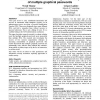Free Online Productivity Tools
i2Speak
i2Symbol
i2OCR
iTex2Img
iWeb2Print
iWeb2Shot
i2Type
iPdf2Split
iPdf2Merge
i2Bopomofo
i2Arabic
i2Style
i2Image
i2PDF
iLatex2Rtf
Sci2ools
CHI
2007
ACM
2007
ACM
Pictures at the ATM: exploring the usability of multiple graphical passwords
Users gain access to cash, confidential information and services at Automated Teller Machines (ATMs) via an authentication process involving a Personal Identification Number (PIN). These users frequently have many different PINs, and fail to remember them without recourse to insecure behaviours. This is not a failing of users. It is a usability failing in the ATM authentication mechanism. This paper describes research executed to evaluate whether users find multiple graphical passwords more memorable than multiple PINs. The research also investigates the success of two memory augmentation strategies in increasing memorability of graphical passwords. The results demonstrate that multiple graphical passwords are substantially more effective than multiple PIN numbers. Memorability is further improved by the use of mnemonics to aid their recall. This study will be of interest to HCI practitioners and information security researchers exploring approaches to usable security. Author Keywords...
ATM Authentication Mechanism | CHI 2007 | Graphical User Interfaces | Human Computer Interaction | Multiple Graphical Passwords |
| Added | 30 Nov 2009 |
| Updated | 30 Nov 2009 |
| Type | Conference |
| Year | 2007 |
| Where | CHI |
| Authors | Wendy Moncur, Grégory Leplâtre |
Comments (0)

